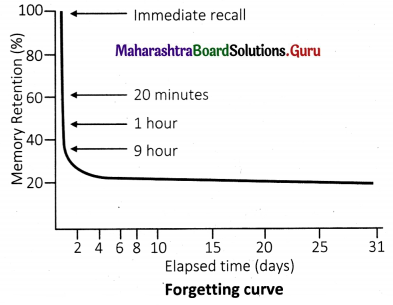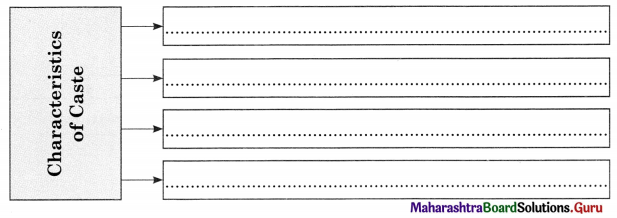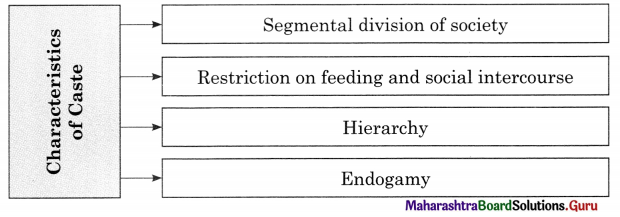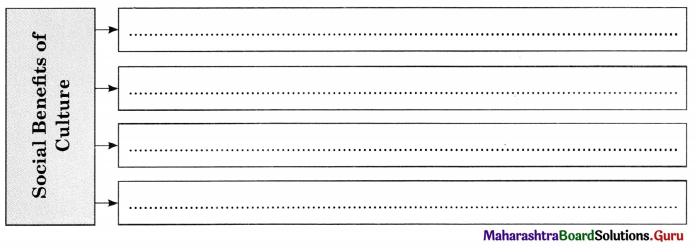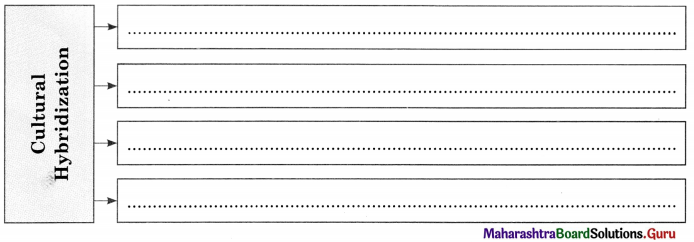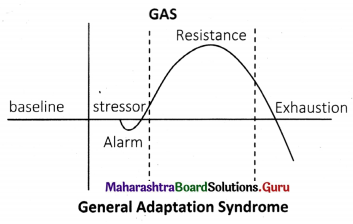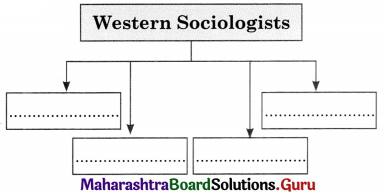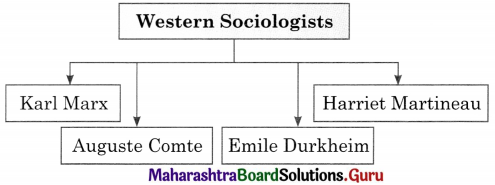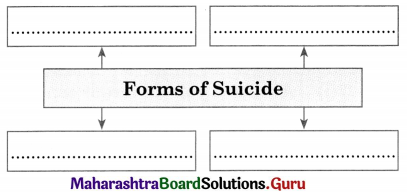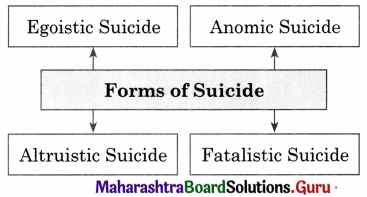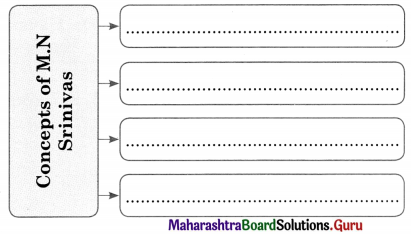Balbharti Maharashtra State Board Class 11 Sociology Important Questions Chapter 4 Social Institutions Important Questions and Answers.
Maharashtra State Board 11th Sociology Important Questions Chapter 4 Social Institutions
Choose the correct alternative and complete the statements.
Question 1.
A social ……………….. is a structure of society that is organized to meet the needs of people.
(association / institution / marriage)
Answer:
institution
Question 2.
The ……………… perspective looks at social institutions as playing the number of specific roles in facilitating human social life.
(conflict / functionalist / Marxist)
Answer:
functionalist

Question 3.
The ……………… perspective holds that social institutions operate in the interest of the dominant sections of society.
(functionalist / conflict / gender)
Answer:
conflict
Question 4.
……………… is the most important primary unit of human society.
(Neighbour / Family / School)
Answer:
Family
Question 5.
………………. forms the basic micro social institutions.
(School / Fatuity / Marriage)
Answer:
Family
Question 6.
……………….. is a group of people related by blood or marriage.
(Marriage / School / Family)
Answer:
Family
Question 7.
………………. refers to a family form which developed in Israel after the Second World War.
(Marxism / Kibbutzism / Monogamy)
Answer:
Kibbutzism
Question 8.
According to Talcott Parsons, family fulfils the basic need of ……………….. socialization.
(secondary / tertiary / primary)
Answer:
Primary
Question 9.
………………. family is considered as a very strong feature of rural society in India.
(Nuclear / Joint / Egalitarian)
Answer:
Joint
Question 10.
…………….. families are commonly seen in urban areas.
(Joint / Nuclear / Matriarchal)
Answer:
Nuclear
Question 11.
In a …………….. family authority rests at the hands of the mother.
(matriarchal / patriarchal / neo-local)
Answer:
matriarchal
Question 12.
In a …………….. family authority rests at the hands of the male head.
(matriarchal / nuclear / patriarchal)
Answer:
patriarchal
Question 13.
In matriarchal family, residence after marriage is ……………..
(matrilocal / patrilocal / matrilineal)
Answer:
matrilocal
Question 14.
The name of the father’s side continues to the next generation is known as ……………..
(matronymic / matrilineal / patronymic)
Answer:
patronymic
Question 15.
…………….. is a social institution through which family relations are formed.
(Family / Education / Marriage)
Answer:
Marriage
Question 16.
……………… is a relatively permanent bond between permissible mates.
(Marriage i Family / Social)
Answer:
Marriage
Question 17.
…………………. denotes marriage to one spouse at a time.
(Polygamy / Monogamy / Polyandry)
Answer:
Monogamy

Question 18.
…………….. denotes marriage to more than one partner at a given time.
(Polygamy / Monogamy / Polyandry)
Answer:
Polygamy
Question 19.
…………….. is a form of marriage wherein one woman marries more than one man at a given time.
(Polygyny / Polyandry / Monogamy)
Answer:
Polyandry
Question 20.
…………….. is a form of marriage wherein one man has two or more wives at a time.
(Polygyny / Polyandry / Monogamy)
Answer:
Polygyny
Question 21.
…………….. denotes marriage within a culturally defined group.
(Endogamy / Exogamy / Monogamy)
Answer:
Endogamy
Question 22.
…………….. denotes marriage outside individual’s own group.
(Endogamy / Exogamy / Monogamy)
Answer:
Exogamy
Question 23.
In …………….. a man marries a woman of a lower social group.
(hypogamy / hypergamy / endogamy)
Answer:
hypergamy
Question 24.
In …………….. a man marries a woman of a higher social status.
(hypogamy / hypergamy / endogamy)
Answer:
hypogamy
Question 25.
…………….. became the first country to formally recognize homosexual marriages.
(Japan / Denmark / Munich).
Answer:
Denmark
Question 26.
…………….. ties are connections between individuals that connect blood relatives.
(Marriage / Kinship / Family)
Answer:
Kinship
Question 27.
The family of birth is called the family of ……………..
(procreation / orientation / kinship)
Answer:
orientation
Question 28.
The family in which a person is married is called a family of ……………..
(procreation / orientation / kinship)
Answer:
procreation
Question 29.
…………….. involved using technology of large-scale farming.
(Pastoral / Agriculture / Hunting)
Answer:
Agriculture
Question 30.
Industrial revolution first took place in ……………..
(Europe / America / England)
Answer:
England
Question 31.
The steam engine was invented by …………….. in 1765.
(John Stevens / James Watt / Guglielmo Marconi)
Answer:
James Watt
Question 32.
The …………….. reduced the use of animal and human muscle energy.
(hydroelectric / machine / steam engine)
Answer:
steam engine
Question 33.
Use of machinery gave rise to a new workplace called ……………..
(factory / office / labour)
Answer:
factory

Question 34.
…………….. economy developed the manufacturing sector very fast.
(Domestic / Industrial / Small-scale)
Answer:
Industrial
Question 35.
…………….. created huge economic gaps in the society.
(Urbanisation / Industrialisation / Modernisation)
Answer:
Industrialisation
Question 36.
By the middle of …………….. century, the nature of production started to change.
(18th, 19th, 20th)
Answer:
20th
Question 37.
The …………….. revolution demands a new set of skills.
(Industrial / Information / French)
Answer:
Information
Question 38.
The first Barbie doll was made in …………….. in 1959.
(China / Japan / Arabia)
Answer:
Japan
Question 39.
The term …………….. refers to the actualisation of potentials of an individual.
(economy / education / information)
Answer:
education
Question 40.
In …………….. societies, education was part of the larger process of socialization and enculturation.
(modern / primitive / traditional)
Answer:
primitive
Question 41.
…………….. societies are characterised by complex division of labour.
(Modern / Primitive / Traditional)
Answer:
Modern
Question 42.
…………….. education is planned with a specific end in view.
(Formal / Informal / Non-formal)
Answer:
Formal
Question 43.
…………….. education is a process by which an individual imbibes attitude.
(Formal / Informal / Non-formal)
Answer:
Informal
Question 44.
…………….. education takes place outside the realm of formal education.
(Formal / Informal / Non-formal)
Answer:
Non-formal
Question 45.
…………….. education requires flexibility in design of the curriculum and scheme of evaluation.
(Formal / Informal / Non-formal)
Answer:
Non-formal
Question 46.
The …………….. requires a certain level of knowledge and skills.
(family / school / workplace)
Answer:
workplace
Question 47.
…………….. instil the value of individual achievement in children.
(Family / Schools / Marriage)
Answer:
Schools
Question 48.
…………….. corporations play a crucial role in creating a flexible economy.
(Transnational / National / Inter-national)
Answer:
Transnational
Correct the incorrect pair.
Question 1.
(a) The principles of communal living – Kibbutz
(b) Regulation of sexual activity – Family
(c) Fulfils material needs – Economy
(d) Disseminate ideas and knowledge – Marriage
Answer:
(d) Disseminate ideas and knowledge – Education
Question 2.
(a) Limited to a specific period – Formal Education
(b) No fix curriculum – Distance Education
(c) Designs curriculum – Schools
(d) Design to serve learning needs of an identified homogeneous group – Non-formal Education
Answer:
(b) No fix curriculum – Informal Education

Question 3.
(a) New forms of energy – Industrial Revolution
(b) Increase in food production – Agricultural Education
(c) Expansion of service sectors – The Information Age Revolution
(d) Division of labour – Stone Age
Answer:
(d) Division of labour – Industrial Revolution
Question 4.
(a) Descent through mother’s line – Matriarchal
(b) Descent through father’s line – Patrilineal
(c) The name through mother’s line – Matronymic
(d) The name through father’s line – Patronymic
Answer:
(a) Descent through mother’s line – Matrilineal
Question 5.
(a) Garo and Khasi – Matriarchal System
(b) Sharing of a household by an unmarried couple – Cohabitation
(c) Extended family – Joint Family
(d) Consist of two generations – Patriarchal Family
Answer:
(d) Consists of two generations – Nuclear Family
Question 6.
(a) Elevates position of woman – Hypergamy
(b) Elevates position of man – Endogamy
(c) Gotra – Exogamy
(d) Caste, sect, tribe – Endogamy
Answer:
(b) Elevates position of man – Hypogamy
Identify the appropriate term from the given options.
(Monogamy, Polygamy, Polygyny, Polyandry, Economy, Consanguinal Kin, Orientation, Affines, Procreation, Global Commodity, Education, Industrialization)
Question 1.
Extreme poverty is one of the reasons for this form of marriage.
Answer:
Polyandry
Question 2.
The most accepted form of marriage.
Answer:
Monogamy
Question 3.
This form of marriage can be seen as a strategy which allows powerful males to control reproductive resources.
Answer:
Polygyny
Question 4.
The kin related through blood.
Answer:
Consanguinal kin
Question 5.
The kin related through marriage.
Answer:
affines
Question 6.
The family of birth.
Answer:
Orientation
Question 7.
Barbie doll.
Answer:
Global commodity
Question 8.
A system of production.
Answer:
Economy
Question 9.
Mass production and distribution.
Answer:
Industrialization

Question 10.
A process that broadens an individual’s cognitive horizons.
Answer:
Education
Correct underlined words and complete the sentence.
Question 1.
A brahmin boy marrying a girl from his Brahmin caste group is an example of exogamy.
Answer:
A brahmin boy marrying a girl from his Brahmin caste group is an example of endogamy.
Question 2.
In Hindus, marriage outside Gotra is practised, is an example of endogamy.
Answer:
In Hindus, marriage outside Gotra is practised, is an example of exogamy.
Question 3.
The eldest female is the head in patriarchal family.
Answer:
The eldest female is the head in matriarchal family.
Question 4.
School provides social identity to its members.
Answer:
Family provides social identity to its members.
Question 5.
Nair’s of south India follow patriarchal family.
Answer:
Nair’s of south India follow matriarchal family.
Question 6.
Step-parenting is the sharing of household by an unmarried couple.
Answer:
Cohabitation is the sharing of household by an unmarried couple.
Question 7.
Family is sanctioned by society to enter sex relations and procreate.
Answer:
Marriage is sanctioned by society to enter sex relations and procreate.
Question 8.
The educational system is based on large-scale capital investment.
Answer:
The industrial system is based on large-scale capital investment.
Question 9.
The development of computer and industrial technology is a third technological revolution.
Answer:
The development of computer and information technology is a third technological revolution.
Question 10.
Coca-Cola, Colgate, Palmolive are example of National Corporations.
Answer:
Coca-Cola, Colgate, Palmolive are example of Transnational Corporations.
Question 11.
In industrial societies there was no economic need for education.
Answer:
In pre-industrial societies there was no economic need for education.
Question 12.
Increased urbanization has led to demand for literate and numerate workforce.
Answer:
Increased industrialization has led to demand for literate and numerate workforce.
Question 13.
The curriculum of informal education is designed to meet the needs of society.
Answer:
The curriculum of formal education is designed to meet the needs of society.
Question 14.
Learning through work experience, travel or mass media is an example of non-formal education.
Answer:
Learning through work experience, travel or mass media is an example of informal education.
Question 15.
Children learn self-discipline through workplace.
Answer:
Children learn self-discipline through school.

Question 16.
The society inequalities are mirrored in the organization of schools.
Answer:
The workplace inequalities are mirrored in the organization of schools.
Question 17.
Bowles and Gintis analysed the relationship between education and economy.
Answer:
Bourdieu analysed the relationship between education and economy.
Write suitable examples of given concepts and justify your answer.
Question 1.
Residence after marriage.
Answer:
On the basis of authority two broad forms of family can be identified, matriarchal family and patriarchal family.
Example : The Garo and Khasi tribes of North East India and the Nair’s of south India follow the matriarchal system. In case of Matriarchal family residence after marriage is matrilocal i.e., the bridegroom lives with the wife’s, family.
Example: It is most widespread form of family in India and most parts of the world. In Patriarchal system, residence after marriage is patrilocal. The married couple live with the husband’s family.
Question 2.
Non-formal education program.
Answer:
Example : Literacy and basic education for adults and young people.
Health education, gender education, swimming sessions etc.
Non-formal education refers to any systematic educational activity carried outside the framework of the established formal system.
It is designed to serve the learning needs of an identified, homogeneous group. It requires flexibility in design of the curriculum and scheme of evaluation.
Question 3.
Informal Education.
Answer:
Example: The child learns language and other basic behavioural patterns in family. Neighbourhood also provides a great source of learning for children. All incidental and spontaneous learning through various possibilities such as work experience, travel or mass media.
Informal education is a process by which an individual imbibes attitudes, develops skills, cultivates values and acquires knowledge without any systematic organization.
There is no fixed curriculum, timetable or deliberate agency to impart informal education. In this sense, informal education is a continuous process and would include all incidental and spontaneous learning.
Question 4.
Monogamy a popular form of marriage.
Answer:
Example : Many societies have laws to uphold the practice of monogamy, India and many other countries strictly promote monogamy. It is more accepted and popular form of marriage. Monogamy denotes marriage to one spouse at a time. In this form, a man can have only one wife, and woman can have only one husband at a time. Monogamy is the most familiar pattern of marriage for most of us.

Question 5.
Changing nature of work.
Answer:
Example : The manufacturing of the most popular Barbie doll, is one illustration of the global commodity chain and changing nature of work.
Changing nature of work and advanced industrialization has led to the decline in the proportion of population engaged in agriculture.
There is an expansion of service sector and an enormous expansion of economic interdependence. Today, the world economy operates through the exchange of capital, labour, raw material and technology. We are all dependent on an immense number of workers – stretching all across the world. Show less
Write short notes.
Question 1.
Types of family based on structure.
Answer:
Family is broadly classified into two forms based on its structure.
Joint family : Joint family consists of two or more generations living under the same roof and sharing a common kitchen. Joint family is considered as a very strong feature and backbone of rural society in India. Joint family is sometimes called extended family.
Nuclear family : Nuclear family consists of two generations, parents and their children. Nuclear families are commonly seen in urban areas.
Question 2.
Education and social division.
Answer:
Scholars like Bowles and Gintis argue that workplace inequalities are mirrored in the organisation of schools and that the education system reproduces these inequalities.
Schools are usually organised in such a way that students perceived to be destined for lower levels of work are expected to follow rules and are given simple, repetitive tasks, while for those students destined for higher level tasks, there is an emphasis on independent thinking and working. Schools routinely design curriculum according to the social background of students. We go to different kinds of schools depending upon our socio-economic background and we acquire different kinds of privileges and opportunities.
Many studies have pointed out that education as a system also perpetuates gender differences. For instance, preference for a boy’s schooling over a girl’s, or high school drop out rate among girls, or soft subject choices for girls, displays gender difference through education.
Question 3.
Forms of Marriage.
Answer:
The forms of marriage exist on the basis of the number of partners and rules governing who can marry whom. On the basis of the number of partners, two major forms of marriage are observed.
Monogamy : Monogamy denotes marriage to one spouse at a time. Monogamy is the most familiar pattern of marriage for most of us. It is more popular and accepted form of marriage. Many societies have laws to uphold this practice.
Polygamy : Polygamy denotes marriage to more than one partner at a given time. Polygamy exists in two different forms:
1. Polyandry : It is a form of marriage wherein one woman marries more than one man at a given time. Extreme poverty may be one of the reasons for the practice of polyandry where a single man cannot support a wife and children adequately.
2. Polygyny : It is a form of marriage wherein one man has two or more wives at a time. Polygyny can be seen as a strategy which allows powerful males to control reproductive resources and to tactically manipulate kin ties.
On the basis of rules governing who can marry whom, two major forms of marriage are observed:
- Endogamy denotes marriage within a culturally defined group, (e.g. caste, sect, tribe).
- Exogamy, on the other hand, denotes marriage outside individual’s own group e.g. Gotra.
On the basis of status, two major forms of marriage are observed. Marriages usually take place between partners having similar social status.
Hypergamy : In hypergamy, a man marries a woman of a lower social group or a woman marries ‘up’ which elevates her position in society.
Hypogamy : In hypogamy a man marries ‘up’ or marries a woman of a higher social status group. This type of marriage offers a man from lower rank an entry into the higher rank.
In 1989, Denmark became the first country to formally recognise homosexual marriages.
Differentiate between.
Question 1.
Polyandry and Polygyny.
Answer:
| Polyandry | Polygyny |
| (i) It is a form of marriage wherein one woman marries more than one man at a given time. | (i) It is a form of marriage wherein one man has two or more wives at a time. |
| (ii) Polyandry can be a social response to harsh economic conditions and extreme poverty when a single man cannot adequately support a wife and children. | (ii) Polygyny can be seen as a strategy which allows powerful males to control reproductive resources and to manipulate kin ties. |
| (iii) Polyandry is divided into fraternal and non-fraternal polyandry. | (iii) Polygyny is divided into sororal and non- sororal polygyny. |
| (iv) Polyandry is practiced among Todas, Kotas, Khasas, Ladakhis, Tibetans. | (iv) Polygyny is practised among the Bhil tribe, Muslims, Gonds, Nagas. |
Question 2.
Hypergamy and Hypogamy.
Answer:
| Hypergamy | Hypogamy |
| (i) In hypergamy, a man marries a woman of a lower social status group or a woman marries a man of higher social group. | (i) In Hypogamy, a man marries a woman of a higher social status group, or a woman marries a man of a lower social group. |
| (ii) This type of marriage elevates position of the woman in society. | (ii) The type of marriage elevates position of the man in society. |

Question 3.
Formal Education and Informal Education.
Answer:
| Formal Education | Informal Education |
| (i) Formal education is planned with a specific end in view. | (i) Informal education is a process by which an individual imbibes and acquires knowledge without any systematic organisation. |
| (ii) Formal education has a well-defined and systematic curriculum. | (ii) There is no fixed curriculum, timetable or deliberate agency to impart informal education. |
| (iii) Formal education is provided to fulfill specific ends, hence, it is limited to a specific period. | (iii) Informal education is a continuous process. |
| (iv) Formal education include curriculum based on aims designed according to the needs of society acquiring education through school. | (iv) Informal education involves efforts by parents and elders to help young one to adapt to the environment. |
Explain the following concept with suitable examples.
Question 1.
Kinship
Answer:
1. Kinship ties are connections between individuals, established either through marriage or through the lines of descent that connect blood relatives.
2. The family of birth is called the family of orientation and the family in which a person is married is called a family of procreation. The kin related through blood are termed as consanguinal kin while the kin related through marriage are called affines.
Example : Parent, child, sibling, grandparent, grandchild, uncle, cousin etc.
Question 2.
Endogamy and Exogamy
Answer:
- Endogamy denotes marriage within a culturally defined group. Example : caste, sect, tribe
- Exogamy denotes marriage outside individual’s own group. Example : Gotra, Pravara, Sapinda
Question 3.
Hypergamy and Hypogamy
Answer:
1. In hypergamy, a man marries a woman of a lower social status group or a woman marries a man of higher social group which elevates her position in society.
Example : Anuloma practiced within varna system.
2. In hypogamy a man marries a woman of a higher social status group. This type of marriage offers a man from lower rank an entry into the higher rank.
Example : Prahiloma practiced in varna system.
Complete the concept maps.
Question 1.

Answer:

Question 2.
| Marriage to one spouse at a time. | ———– |
| More than one partner at a given time. | ———– |
| One man has two or more wives at a time. | ———– |
| One woman marries more than one man at a given time. | ———– |
Answer:
| Marriage to one spouse at a time. | Monogamy |
| More than one partner at a given time. | Polygamy |
| One man has two or more wives at a time. | Polygyny |
| One woman marries more than one man at a given time. | Polyandry |
Question 3.
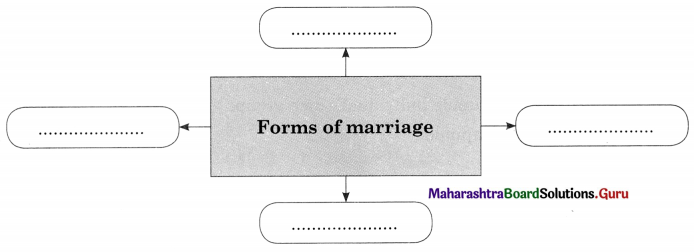
Answer:
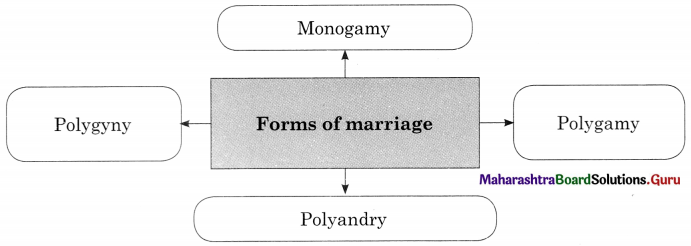

Question 4.

Answer:

Question 5.
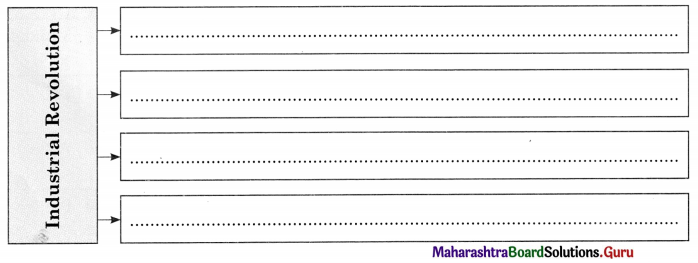
Answer:
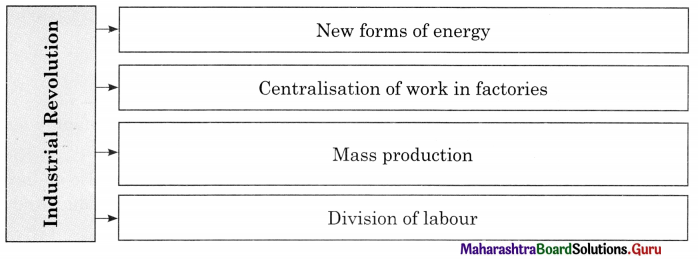
Question 6.

Answer:

Question 7.

Answer:

State whether the following statements are true or false with reasons.
Question 1.
Computer technology has resulted into centralization of work.
Answer:
This statement is False.
- Just as industrialization organised and centralized work under one roof called factories, computer technology is allowing for decentralization of work.
- Laptops, mobiles and accessibility of new information technology can turn any space into a virtual office.
- The Information Revolution demands a new set of individual skills such as the ability to communicate, to write, to present and use computer technology.
Question 2.
The term education refers to the actualization of potentials of an individual.
Answer:
This statement is True.
1. It involves a learning process to gain knowledge and skills not just to survive but to live life more meaningfully.
2. Modern societies have evolved a distinct institution of education to fulfil basic goals-
- To create and disseminate ideas and knowledge.
- To develop skills to use existing knowledge for the betterment of society.
3. Education is thus a broad process of learning that broadens an individual’s cognitive horizons and develops the skills to choose, evaluate and add to existing knowledge which leads to actualization of potentials of an individual.

Question 3.
There is a fixed curriculum, timetable to impart informal education.
Answer:
This statement is False.
- There is no fixed curriculum timetable to impart informal education.
- Informal education involves efforts by parents and elders to help the young ones to adapt to learning.
- Informal education is a continuous process and includes all spontaneous learning through various possibilities such as work experience, travel or mass media.
Question 4.
The education system reproduces social inequalities.
Answer:
This statement is True.
- Scholars like Bourdieu criticize the education system for functioning as the means through which higher classes reproduce their economic domination.
- Schools are usually organised in such a way that students destined for lower levels of work
are expected to follow rules and are given simple, repetitive a tasks, while for those destined for higher level tasks, there is an emphasis on independent thinking and working. - We go to different kinds of schools depending upon our socio-economic background and we acquire different kinds of privileges and opportunities.
Question 5.
Gender still remains a challenge for equal access to educational opportunities.
Answer:
This statement is False.
- Education as a system also perpetrates gender differences
- Although the ‘gender gap’ in education has narrowed, it still remains as a challenge : for equal access to educational opportunities.
- Gender difference is evident enough when we consider issues like, preference for a boy’s schooling over a girl’s or high school drop out rate among girls, or soft subject choices for girls.
Question 6.
The Supreme Court of India, on September 6, 2018 decriminalised section 377.
Answer:
This statement is True.
- The Supreme Court of India on September 6, 2018 decriminalised section 377 of the I. P. C. and allowed gay relation among consenting adults in private.
- The SC ruled out that consensual adult gay sex is not a crime saying that such sexual orientation is natural and people have no control over it.
Question 7.
The conflict perspective holds that all individuals are placed equally in society.
Answer:
This statement is False.
- The conflict perspective holds that all individuals are not placed equally in society. The distribution of privileges and opportunities is skewed and mostly in favour of the affluent section of society.
- Social institutions, from this perspective, contributes to social divisions and inequalities.
- They operate in the interest of the dominant sections of society.
Question 8.
Economic interdependence is one of the main features of industrial societies.
Answer:
This statement is False.
- Economic interdependence is one of the main features of modern societies. In modern societies the world economy operates through the exchange of capital, labour, raw material and technology.
- It is dependent on an immense number of workers – stretching all across the world – for the goods and services.
- Industrial production was centralized. Workers were stationed at fixed positions. Globalized economy work is decentralized hence interdependent.
Give your personal response.
Question 1.
Family is changing in structure and composition, express your views about it.
Answer:
Family system has undergone some change in the late 20th century due to variety of reasons including the need for some members to move from village to city, or from one city to another for employment opportunities. Indian family has to be well prepared for growing challenges to face the changing societal norms to overcome several socio-psychological problems.
Answer the following in detail (About 150-200 words).
Question 1.
Explain how changing nature of work has led to global commodity chain’s or production flexible?
OR
Explain changing nature of work with global economy.
Answer:
One of the main features of modern societies is an enormous expansion of economic interdependence. Today the world economy operates through the exchange of capital, labour, raw material and technology. We all are dependent on large number of workers from all over the world for the s. goods and services we consume. In a globalised economy work is decentralised. It is the growing competition between firms and countries that makes it essential to keep production flexible. This means creation of a global chain of production in which different activities of the production take place in different parts of the world.
For example, raw material may be processed in one country, where it is cheaper and the product may be marketed for consumption in a totally different country. Transnational corporation like Coca- Cola, Colgate, Palmolive, Kodak, General Motors play a crucial role in creating a flexible economy which operation across the globe.

One illustration of the global commodity chain can be found in the manufacturing of the most popular Barbie doll. The first doll was made in Japan in 1959 when wages were low, as wages rose in Japan, Barbie moved to other low wage countries in Asia. Ethylene needed for Barbies plastic body is created in Saudi Arabia. Ethylene is converted to PVC pellets which are shipped to factories in China, Malaysia and Indonesia where actual moulding of the body takes place. Barbies gets her nylon hair from Japan and cotton dresses are made in China.
Barbie is designed in United States where most of the profits are made . But only physical aspects of Barbie that is made in USA is her cardboard packaging along with some of the paints and oils that are used to decorate the doll.
![]()
![]()
![]()
![]()
![]()
![]()
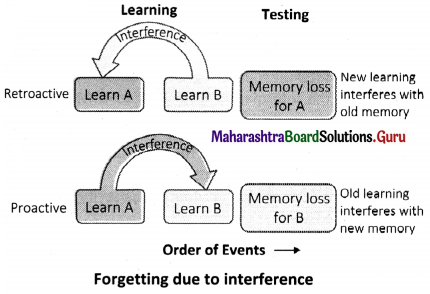
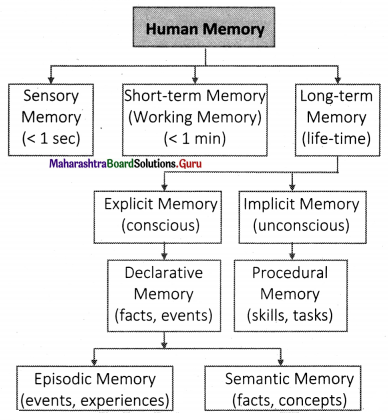

![]()
![]()
